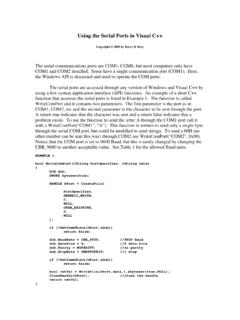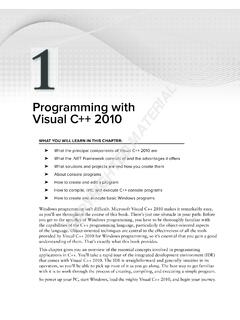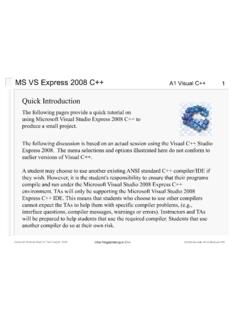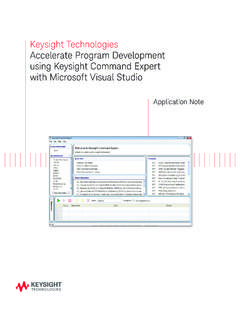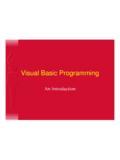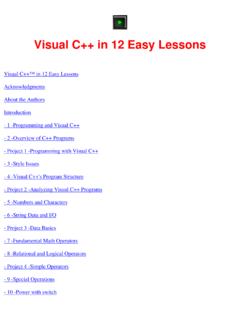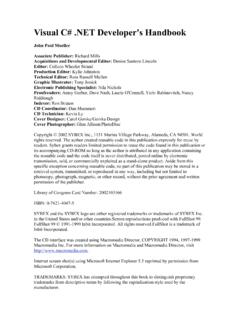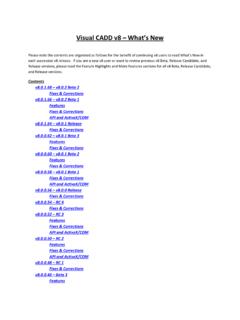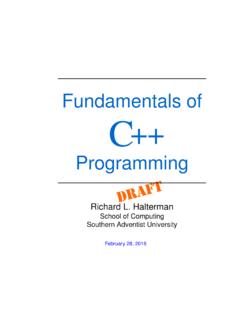Transcription of Visual C# Programming - Davide Vitelaru
1 ; In this tutorial you will learn how to make applications for Windows in C#. You will learn how to use Visual Studio to build simple applications, how to use most of the Windows Forms controls, and several tips on how to publish your application. Made by Davide Vitelaru Visual C# Programming Basics 2 Visual C# Programming BASICS Visual C# Programming BASICS 3 General Requirements To follow this tutorial you will need the following items: Knowing the basics of at least one Programming language (To know what variables, arrays, functions, are) A computer running Windows XP/Vista/7 Microsoft Visual C# Express (Click for download) You can also use Microsoft Visual Studio Professional, but this is a commercial version of the Visual C# Express, and it has more features. We will not use most of them in this tutorial though.
2 If you are interested in some specific part of this tutorial, check out the table of contents on the last page because you might find what you are looking for. Quick Start Your first application In this chapter, you will learn how to make an application in Visual Studio from start to finish. How to code it, design it and publish it. Step 1 Creating the project To start, open Visual C# Express or Visual Studio and create a new project by pressing on the New Project icon in the upper left corner. In the window that opens you can select your project type, depending on what you want to program in C#. To make a simple Windows application, select Windows Forms Application , name your project Calculator (because this is what we are going to do) and press OK . 4 Visual C# Programming BASICS You now created a new project.
3 You might get all scared by Visual C# s interface because it is very crowded and you don t know what most of the controls do. Let s take a look at the interface for a bit: the first thing that pop s into your eyes is the form right in the middle. It is an empty form and what you have to do is to take controls from the Toolbox , the panel from the left, and put them on it. You can see different type of controls in the Toolbox : buttons, textboxes, progress bars, and you can take all of them and place them on your form. Don t place anything on your form now, if you did, select them and delete them. On the right you have your Solution Explorer . When you create a new project, you automatically create a new solution. A solution is a collection of multiple projects, let s say we make an application called Calculator (cause this is what we actually do), and Calculator is an application project inside the Calculator solution.
4 If we want to create a setup for Calculator , we create the setup project inside the same solution. You will learn what everything in the solution explorer means later. Step 2 Designing the form What we want to create is a simple calculator application. What it will do is to add two numbers inserted by the user. To start, we will need three text boxes: Two for the two numbers that the user wants to add and the third for the result. We will also need a button so that the user can press it and receive he s result. To do all this, click on the Text Box control in the toolbox, and then click on your form. As you can see, a text box appeared on your form. Repeat this step again and create two more text boxes. Align the text boxes the same way I did: Visual C# Programming BASICS 5 Now, select the button control from the toolbox and create a button on the form.
5 Good, we now created all the controls we need for our application. But, there is a problem, why is the button named Button1 ? Because this is how it is by default, to change that, we need to change its properties. By default, the properties window is not opened in Visual C#. To open it, go to View and click on Properties . The properties panel (obviously) shows the select controls properties, such as height, width, color, text, In this case, we only need to change the text since the button can be resized with using the mouse. Click on the button (Make sure you don t double click it, or its code will open. If that happens, close the tab with the code from the top of the middle panel). Once clicked, the button s properties will appear in the Properties window. Scroll down and go to Text . To its right you will see Button1.
6 Change that to Add , and press enter. 6 Visual C# Programming BASICS Your button now has Add written on it. Very good, this way you can edit every item s properties, even the text boxes . Also, you might notice that the form s name is Form1 . Try to do something about it. How To: Click on an empty space on the form, change the form s text property to Calculator . Step 3 Debugging the application Of course, we added the controls on our form, but the button doesn t do anything since we didn t tell it do to anything. You can see your program running by pressing the Debug button, the green arrow in the toolbar (). When you click the debug button, you application will start. It should look something like this: You probably tried to click the button already, and noticed how well he is doing his job. Debugging is the best method to test your application before publishing it.
7 Every time you make a change to it, you debug it to see if it worked. Once you finish the application, you build the entire project turning everything into one executable, and probably make a setup for your application. Step 4 Coding the application To make the application work, you obviously have to write some code. If you are still debugging your application, close it and go back to your project. Now, double click on your button to open the code window. As you can see, everything is tabbed in the project. You can always go back to the form designer by clicking its tab on the top. With all the amount of code that you have in front of you, you might get scared (again!). Don t worry you will get used to it, and to even more than that. If you are reading this tutorial, let s hope you already know the basics of another Programming language, if not it will be hard for you to search Wikipedia for every word you don t understand, but it would be useful.
8 The first statements in the code import some items from the .NET Framework. What is that you might ask, the .NET Framework is a large library of coded solutions to common Programming problems that manages the execution of programs written specifically for the framework. To be clearer, it is a large Visual C# Programming BASICS 7 amount of code already written for you, so you can build programs with a pretty user interface and other things. It helps you very much because it reduces the amount of things that you need to learn to create the entire user interface. We should all thank Microsoft for it: using System; using ; using ; using ; using ; using ; using ; using ; By import some things from the .NET Framework, I meant importing some classes. Those classes can be the forms, the user controls, and all the other things that helped us by now creating the program.
9 You will learn the meaning of them later. For now, let s see the rest of the code: namespace Calculator { public partial class Form1 : Form { public Form1() { InitializeComponent(); } private void button1_Click(object sender, EventArgs e) { } } } The public Form1() statement is a class that is executed when we start the program; actually, when we open the form named ( .cs is from C Sharp). In case you did not know, in C# the code is usually put between curly braces just like in Java and C++. The private void button1_Click(object sender, EventArgs e) is that class that is executed when we click the button. Inside it, we will write the code that will add the two values from the text boxes. Note: In C#, two slashes (//) represents the beginning of a comment.
10 A comment is a piece of code that is not executed by the compiler, it is used to help you organize you code, and so that other programmers will understand what every piece of code means. We will use comments inside our codes for better explanation. To make that button add the two values and return the sum we need, we have to grab the text content from the two text boxes, turn it to integers, add them, and change the text of the third text box to the sum. It is very simple: double val1, val2; //We declare two double type variables //We assign to the first variable the value of the text box //Since the text box cand hold a string, it must be converted //to a double to assign it to "val1". 8 Visual C# Programming BASICS //Note that we assign using = as an operator val1 = ( ); ("string") converts the string put into the brackets //and assigns it to a double //Same thing for the second variable val2 = ( ); //Now we are doing the exact oposite, we take the two //double values and we convert their sum to a string //using the.
